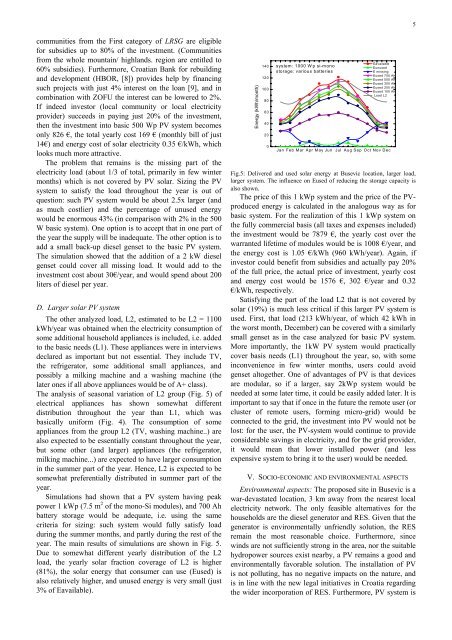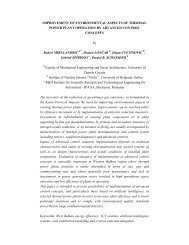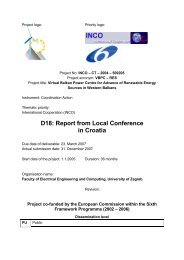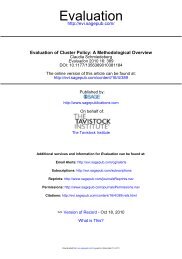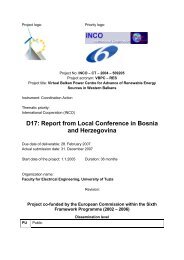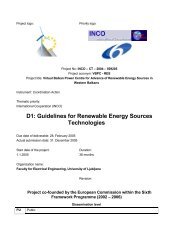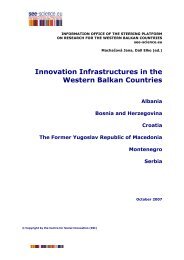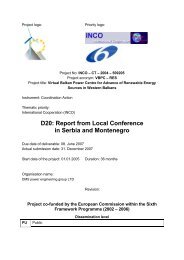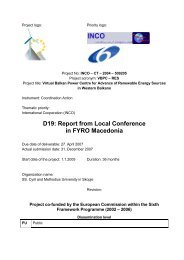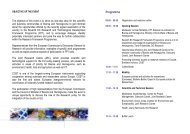Prva stran - WBC-INCO Net
Prva stran - WBC-INCO Net
Prva stran - WBC-INCO Net
Create successful ePaper yourself
Turn your PDF publications into a flip-book with our unique Google optimized e-Paper software.
communities from the First category of LRSG are eligible<br />
for subsidies up to 80% of the investment. (Communities<br />
from the whole mountain/ highlands. region are entitled to<br />
60% subsidies). Furthermore, Croatian Bank for rebuilding<br />
and development (HBOR, [8]) provides help by financing<br />
such projects with just 4% interest on the loan [9], and in<br />
combination with ZOFU the interest can be lowered to 2%.<br />
If indeed investor (local community or local electricity<br />
provider) succeeds in paying just 20% of the investment,<br />
then the investment into basic 500 Wp PV system becomes<br />
only 826 €, the total yearly cost 169 € (monthly bill of just<br />
14€) and energy cost of solar electricity 0.35 €/kWh, which<br />
looks much more attractive.<br />
The problem that remains is the missing part of the<br />
electricity load (about 1/3 of total, primarily in few winter<br />
months) which is not covered by PV solar. Sizing the PV<br />
system to satisfy the load throughout the year is out of<br />
question: such PV system would be about 2.5x larger (and<br />
as much costlier) and the percentage of unused energy<br />
would be enormous 43% (in comparison with 2% in the 500<br />
W basic system). One option is to accept that in one part of<br />
the year the supply will be inadequate. The other option is to<br />
add a small back-up diesel genset to the basic PV system.<br />
The simulation showed that the addition of a 2 kW diesel<br />
genset could cover all missing load. It would add to the<br />
investment cost about 30€/year, and would spend about 200<br />
liters of diesel per year.<br />
D. Larger solar PV system<br />
The other analyzed load, L2, estimated to be L2 = 1100<br />
kWh/year was obtained when the electricity consumption of<br />
some additional household appliances is included, i.e. added<br />
to the basic needs (L1). These appliances were in interviews<br />
declared as important but not essential. They include TV,<br />
the refrigerator, some additional small appliances, and<br />
possibly a milking machine and a washing machine (the<br />
later ones if all above appliances would be of A+ class).<br />
The analysis of seasonal variation of L2 group (Fig. 5) of<br />
electrical appliances has shown somewhat different<br />
distribution throughout the year than L1, which was<br />
basically uniform (Fig. 4). The consumption of some<br />
appliances from the group L2 (TV, washing machine..) are<br />
also expected to be essentially constant throughout the year,<br />
but some other (and larger) appliances (the refrigerator,<br />
milking machine...) are expected to have larger consumption<br />
in the summer part of the year. Hence, L2 is expected to be<br />
somewhat preferentially distributed in summer part of the<br />
year.<br />
Simulations had shown that a PV system having peak<br />
power 1 kWp (7.5 m 2 of the mono-Si modules), and 700 Ah<br />
battery storage would be adequate, i.e. using the same<br />
criteria for sizing: such system would fully satisfy load<br />
during the summer months, and partly during the rest of the<br />
year. The main results of simulations are shown in Fig. 5.<br />
Due to somewhat different yearly distribution of the L2<br />
load, the yearly solar fraction coverage of L2 is higher<br />
(81%), the solar energy that consumer can use (Eused) is<br />
also relatively higher, and unused energy is very small (just<br />
3% of Eavailable).<br />
Energy (kWh/month)<br />
140<br />
120<br />
100<br />
80<br />
60<br />
40<br />
20<br />
0<br />
system: 1000 Wp si-mono<br />
storage: various batteries<br />
Eavailable<br />
Eunused<br />
E missing<br />
Eused 700 Ah<br />
Eused 500 Ah<br />
Eused 300 Ah<br />
Eused 200 Ah<br />
Eused 100 Ah<br />
Load L2<br />
Jan Feb Mar Apr May Jun Jul Aug Sep Oct Nov Dec<br />
Fig.5: Delivered and used solar energy at Busevic location, larger load,<br />
larger system. The influence on Eused of reducing the storage capacity is<br />
also shown.<br />
The price of this 1 kWp system and the price of the PVproduced<br />
energy is calculated in the analogous way as for<br />
basic system. For the realization of this 1 kWp system on<br />
the fully commercial basis (all taxes and expenses included)<br />
the investment would be 7879 €, the yearly cost over the<br />
warranted lifetime of modules would be is 1008 €/year, and<br />
the energy cost is 1.05 €/kWh (960 kWh/year). Again, if<br />
investor could benefit from subsidies and actually pay 20%<br />
of the full price, the actual price of investment, yearly cost<br />
and energy cost would be 1576 €, 302 €/year and 0.32<br />
€/kWh, respectively.<br />
Satisfying the part of the load L2 that is not covered by<br />
solar (19%) is much less critical if this larger PV system is<br />
used. First, that load (213 kWh/year, of which 42 kWh in<br />
the worst month, December) can be covered with a similarly<br />
small genset as in the case analyzed for basic PV system.<br />
More importantly, the 1kW PV system would practically<br />
cover basis needs (L1) throughout the year, so, with some<br />
inconvenience in few winter months, users could avoid<br />
genset altogether. One of advantages of PV is that devices<br />
are modular, so if a larger, say 2kWp system would be<br />
needed at some later time, it could be easily added later. It is<br />
important to say that if once in the future the remote user (or<br />
cluster of remote users, forming micro-grid) would be<br />
connected to the grid, the investment into PV would not be<br />
lost: for the user, the PV-system would continue to provide<br />
considerable savings in electricity, and for the grid provider,<br />
it would mean that lower installed power (and less<br />
expensive system to bring it to the user) would be needed.<br />
V. SOCIO-ECONOMIC AND ENVIRONMENTAL ASPECTS<br />
Environmental aspects: The proposed site in Busevic is a<br />
war-devastated location, 3 km away from the nearest local<br />
electricity network. The only feasible alternatives for the<br />
households are the diesel generator and RES. Given that the<br />
generator is environmentally unfriendly solution, the RES<br />
remain the most reasonable choice. Furthermore, since<br />
winds are not sufficiently strong in the area, nor the suitable<br />
hydropower sources exist nearby, a PV remains a good and<br />
environmentally favorable solution. The installation of PV<br />
is not polluting, has no negative impacts on the nature, and<br />
is in line with the new legal initiatives in Croatia regarding<br />
the wider incorporation of RES. Furthermore, PV system is<br />
5


